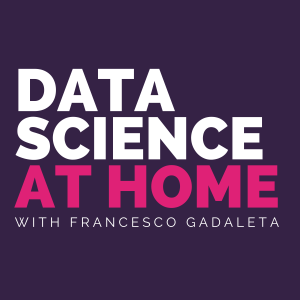About this Show
Data Science at Home is a podcast about machine learning, artificial intelligence and algorithms.
The show is hosted by Dr. Francesco Gadaleta on solo episodes and interviews with some of the most influential figures in the field
Cutting through AI bullsh*t.
Come join the discussion on Discord!
https://discord.gg/4UNKGf3

Tuesday Nov 05, 2019
Tuesday Nov 05, 2019
Tuesday Nov 05, 2019
In this episode I speak with Jon Krohn, author of Deeplearning Illustrated a book that makes deep learning easier to grasp.
We also talk about some important guidelines to take into account whenever you implement a deep learning model, how to deal with bias in machine learning used to match jobs to candidates and the future of AI.
You can purchase the book from informit.com/dsathome with code DSATHOME and get 40% off books/eBooks and 60% off video training
![[RB] How to generate very large images with GANs (Ep. 85)](https://pbcdn1.podbean.com/imglogo/ep-logo/pbblog1799802/data_science_at_home_podcast_cover_300x300.png)
Monday Nov 04, 2019
Monday Nov 04, 2019
Monday Nov 04, 2019
Join the discussion on our Discord server
In this episode I explain how a research group from the University of Lubeck dominated the curse of dimensionality for the generation of large medical images with GANs. The problem is not as trivial as it seems. Many researchers have failed in generating large images with GANs before. One interesting application of such approach is in medicine for the generation of CT and X-ray images.Enjoy the show!
References
Multi-scale GANs for Memory-efficient Generation of High Resolution Medical Images https://arxiv.org/abs/1907.01376

Sunday Oct 27, 2019
Sunday Oct 27, 2019
Sunday Oct 27, 2019
Some of the most powerful NLP models like BERT and GPT-2 have one thing in common: they all use the transformer architecture. Such architecture is built on top of another important concept already known to the community: self-attention.In this episode I explain what these mechanisms are, how they work and why they are so powerful.
Don't forget to subscribe to our Newsletter or join the discussion on our Discord server
References
Attention is all you need https://arxiv.org/abs/1706.03762
The illustrated transformer https://jalammar.github.io/illustrated-transformer
Self-attention for generative models http://web.stanford.edu/class/cs224n/slides/cs224n-2019-lecture14-transformers.pdf
![[RB] Replicating GPT-2, the most dangerous NLP model (with Aaron Gokaslan) (Ep. 83)](https://pbcdn1.podbean.com/imglogo/ep-logo/pbblog1799802/data_science_at_home_podcast_cover_300x300.png)
Friday Oct 18, 2019
Friday Oct 18, 2019
Join the discussion on our Discord server
In this episode, I am with Aaron Gokaslan, computer vision researcher, AI Resident at Facebook AI Research. Aaron is the author of OpenGPT-2, a parallel NLP model to the most discussed version that OpenAI decided not to release because too accurate to be published.
We discuss about image-to-image translation, the dangers of the GPT-2 model and the future of AI. Moreover, Aaron provides some very interesting links and demos that will blow your mind!
Enjoy the show!
References
Multimodal image to image translation (not all mentioned in the podcast but recommended by Aaron)
Pix2Pix:
https://phillipi.github.io/pix2pix/
CycleGAN:
https://junyanz.github.io/CycleGAN/
GANimorph
Paper: https://arxiv.org/abs/1808.04325
Code: https://github.com/brownvc/ganimorph
UNIT:https://arxiv.org/abs/1703.00848
MUNIT:https://github.com/NVlabs/MUNIT
DRIT: https://github.com/HsinYingLee/DRIT
GPT-2 and related
Try OpenAI's GPT-2: https://talktotransformer.com/
Blogpost: https://blog.usejournal.com/opengpt-2-we-replicated-gpt-2-because-you-can-too-45e34e6d36dc
The Original Transformer Paper: https://arxiv.org/abs/1706.03762
Grover: The FakeNews generator and detector: https://rowanzellers.com/grover/

Tuesday Oct 15, 2019
Tuesday Oct 15, 2019
Tuesday Oct 15, 2019
Join the discussion on our Discord server
After reinforcement learning agents doing great at playing Atari video games, Alpha Go, doing financial trading, dealing with language modeling, let me tell you the real story here.In this episode I want to shine some light on reinforcement learning (RL) and the limitations that every practitioner should consider before taking certain directions. RL seems to work so well! What is wrong with it?
Are you a listener of Data Science at Home podcast? A reader of the Amethix Blog? Or did you subscribe to the Artificial Intelligence at your fingertips newsletter? In any case let’s stay in touch! https://amethix.com/survey/
References
Emergence of Locomotion Behaviours in Rich Environments https://arxiv.org/abs/1707.02286
Rainbow: Combining Improvements in Deep Reinforcement Learning https://arxiv.org/abs/1710.02298
AlphaGo Zero: Starting from scratch https://deepmind.com/blog/article/alphago-zero-starting-scratch

Thursday Oct 10, 2019
Thursday Oct 10, 2019
Join the discussion on our Discord server
In this episode I have an amazing conversation with Jimmy Soni and Rob Goodman, authors of “A mind at play”, a book entirely dedicated to the life and achievements of Claude Shannon. Claude Shannon does not need any introduction. But for those who need a refresh, Shannon is the inventor of the information age.
Have you heard of binary code, entropy in information theory, data compression theory (the stuff behind mp3, mpg, zip, etc.), error correcting codes (the stuff that makes your RAM work well), n-grams, block ciphers, the beta distribution, the uncertainty coefficient?
All that stuff has been invented by Claude Shannon :)
Articles:
https://medium.com/the-mission/10-000-hours-with-claude-shannon-12-lessons-on-life-and-learning-from-a-genius-e8b9297bee8f
https://medium.com/the-mission/on-claude-shannons-103rd-birthday-here-are-103-memorable-claude-shannon-quotes-maxims-and-843de4c716cf?source=your_stories_page---------------------------
http://nautil.us/issue/51/limits/how-information-got-re_invented
http://nautil.us/issue/50/emergence/claude-shannon-the-las-vegas-cheat
Claude's papers:
https://medium.com/the-mission/a-genius-explains-how-to-be-creative-claude-shannons-long-lost-1952-speech-fbbcb2ebe07f
http://www.math.harvard.edu/~ctm/home/text/others/shannon/entropy/entropy.pdf
A mind at play (book links):
http://amzn.to/2pasLMz -- Hardcover
https://amzn.to/2oCfVL0 -- Audio

Tuesday Oct 01, 2019
Tuesday Oct 01, 2019
Tuesday Oct 01, 2019
Join the discussion on our Discord server
As ML plays a more and more relevant role in many domains of everyday life, it’s quite obvious to see more and more attacks to ML systems. In this episode we talk about the most popular attacks against machine learning systems and some mitigations designed by researchers Ambra Demontis and Marco Melis, from the University of Cagliari (Italy). The guests are also the authors of SecML, an open-source Python library for the security evaluation of Machine Learning (ML) algorithms. Both Ambra and Marco are members of research group PRAlab, under the supervision of Prof. Fabio Roli.
SecML Contributors
Marco Melis (Ph.D Student, Project Maintainer, https://www.linkedin.com/in/melismarco/)Ambra Demontis (Postdoc, https://pralab.diee.unica.it/it/AmbraDemontis) Maura Pintor (Ph.D Student, https://it.linkedin.com/in/maura-pintor)Battista Biggio (Assistant Professor, https://pralab.diee.unica.it/it/BattistaBiggio)
References
SecML: an open-source Python library for the security evaluation of Machine Learning (ML) algorithms https://secml.gitlab.io/.
Demontis et al., “Why Do Adversarial Attacks Transfer? Explaining Transferability of Evasion and Poisoning Attacks,” presented at the 28th USENIX Security Symposium (USENIX Security 19), 2019, pp. 321–338. https://www.usenix.org/conference/usenixsecurity19/presentation/demontis
W. Koh and P. Liang, “Understanding Black-box Predictions via Influence Functions,” in International Conference on Machine Learning (ICML), 2017. https://arxiv.org/abs/1703.04730
Melis, A. Demontis, B. Biggio, G. Brown, G. Fumera, and F. Roli, “Is Deep Learning Safe for Robot Vision? Adversarial Examples Against the iCub Humanoid,” in 2017 IEEE International Conference on Computer Vision Workshops (ICCVW), 2017, pp. 751–759. https://arxiv.org/abs/1708.06939
Biggio and F. Roli, “Wild Patterns: Ten Years After the Rise of Adversarial Machine Learning,” Pattern Recognition, vol. 84, pp. 317–331, 2018. https://arxiv.org/abs/1712.03141
Biggio et al., “Evasion attacks against machine learning at test time,” in Machine Learning and Knowledge Discovery in Databases (ECML PKDD), Part III, 2013, vol. 8190, pp. 387–402. https://arxiv.org/abs/1708.06131
Biggio, B. Nelson, and P. Laskov, “Poisoning attacks against support vector machines,” in 29th Int’l Conf. on Machine Learning, 2012, pp. 1807–1814. https://arxiv.org/abs/1206.6389
Dalvi, P. Domingos, Mausam, S. Sanghai, and D. Verma, “Adversarial classification,” in Tenth ACM SIGKDD International Conference on Knowledge Discovery and Data Mining (KDD), Seattle, 2004, pp. 99–108. https://dl.acm.org/citation.cfm?id=1014066
Sundararajan, Mukund, Ankur Taly, and Qiqi Yan. "Axiomatic attribution for deep networks." Proceedings of the 34th International Conference on Machine Learning-Volume 70. JMLR. org, 2017. https://arxiv.org/abs/1703.01365
Ribeiro, Marco Tulio, Sameer Singh, and Carlos Guestrin. "Model-agnostic interpretability of machine learning." arXiv preprint arXiv:1606.05386 (2016). https://arxiv.org/abs/1606.05386
Guo, Wenbo, et al. "Lemna: Explaining deep learning based security applications." Proceedings of the 2018 ACM SIGSAC Conference on Computer and Communications Security. ACM, 2018. https://dl.acm.org/citation.cfm?id=3243792
Bach, Sebastian, et al. "On pixel-wise explanations for non-linear classifier decisions by layer-wise relevance propagation." PloS one 10.7 (2015): E0130140. https://journals.plos.org/plosone/article?id=10.1371/journal.pone.0130140
![[RB] How to scale AI in your organisation (Ep. 79)](https://pbcdn1.podbean.com/imglogo/ep-logo/pbblog1799802/data_science_at_home_podcast_cover_300x300.png)
Thursday Sep 26, 2019
Thursday Sep 26, 2019
Thursday Sep 26, 2019
Join the discussion on our Discord server
Scaling technology and business processes are not equal. Since the beginning of the enterprise technology, scaling software has been a difficult task to get right inside large organisations. When it comes to Artificial Intelligence and Machine Learning, it becomes vastly more complicated.
In this episode I propose a framework - in five pillars - for the business side of artificial intelligence.

Monday Sep 23, 2019
Monday Sep 23, 2019
Join the discussion on our Discord server
In this episode, I am with Aaron Gokaslan, computer vision researcher, AI Resident at Facebook AI Research. Aaron is the author of OpenGPT-2, a parallel NLP model to the most discussed version that OpenAI decided not to release because too accurate to be published.
We discuss about image-to-image translation, the dangers of the GPT-2 model and the future of AI. Moreover, Aaron provides some very interesting links and demos that will blow your mind!
Enjoy the show!
References
Multimodal image to image translation (not all mentioned in the podcast but recommended by Aaron)
Pix2Pix:
https://phillipi.github.io/pix2pix/
CycleGAN:
https://junyanz.github.io/CycleGAN/
GANimorph
Paper: https://arxiv.org/abs/1808.04325
Code: https://github.com/brownvc/ganimorph
UNIT:https://arxiv.org/abs/1703.00848
MUNIT:https://github.com/NVlabs/MUNIT
DRIT: https://github.com/HsinYingLee/DRIT
GPT-2 and related
Try OpenAI's GPT-2: https://talktotransformer.com/
Blogpost: https://blog.usejournal.com/opengpt-2-we-replicated-gpt-2-because-you-can-too-45e34e6d36dc
The Original Transformer Paper: https://arxiv.org/abs/1706.03762
Grover: The FakeNews generator and detector: https://rowanzellers.com/grover/
![Training neural networks faster without GPU [RB] (Ep. 77)](https://pbcdn1.podbean.com/imglogo/ep-logo/pbblog1799802/data_science_at_home_podcast_cover_300x300.png)
Tuesday Sep 17, 2019
Tuesday Sep 17, 2019
Tuesday Sep 17, 2019
Join the discussion on our Discord server
Training neural networks faster usually involves the usage of powerful GPUs. In this episode I explain an interesting method from a group of researchers from Google Brain, who can train neural networks faster by squeezing the hardware to their needs and making the training pipeline more dense.
Enjoy the show!
References
Faster Neural Network Training with Data Echoinghttps://arxiv.org/abs/1907.05550

Data Science at Home is the top-10 best data science podcasts on Apple Podcasts, Spotify, Stitcher, Podbean and many more aggregators.
We reach our audience on a weekly basis via 30-minute episodes enriched with blog posts and show notes. Our episodes reach a highly targeted audience across a wide demographics and globally distributed.
Data Science at home currently accepts at most two advertising slots per episode. The scheduled episode for your advertising campaign will be defined by our team, depending on the topic and the current advertising queue.
Our team is available to give you recommendations about your application and to discuss rates. Please send a direct email to media@amethix.com to make first contact. After connecting, we will share the best available date for you to proceed with the onboarding.
We promote services and products related to IT, Internet services, Research, Data Science, Machine learning, Fintech and Banking, Healthcare, Energy, etc. Below are some of the most recent statistics of the show.
Contact us and let’s talk about how we can help get your message to the audience of Data Science at Home podcast.
Data Science at Home is a podcast about machine learning, artificial intelligence and algorithms.
The show is hosted by Dr. Francesco Gadaleta on solo episodes and interviews with some of the most influential figures in the field